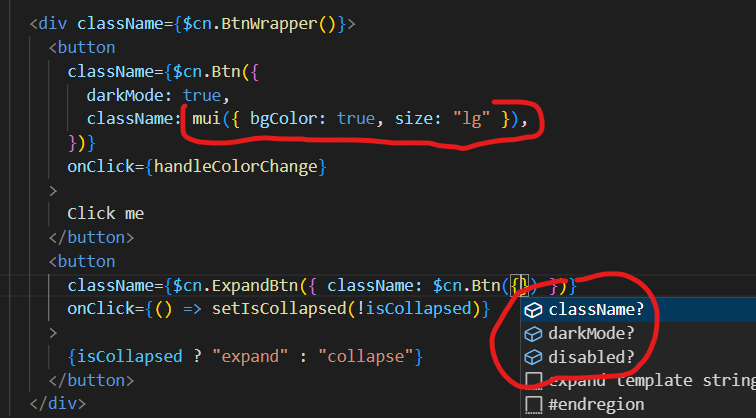Typed classnames loader
This webpack loader provides:
- type definition for css module classNames
- fast classNames mapping
overview
if you define a css stylesheet like this
// style.module.scss
.typography {
font-family: 'Times New Roman', Times, serif;
&--sans-serif {
font-family: Arial, Helvetica, sans-serif;
}
&--bold {
font-weight: bold;
}
// _as_ is a special key to group a couple of classes in one variable defined by a union type of those classes.
// like in the following example (size: sm | lg)
&--sm_as_size {
font-size: 15px;
}
&--lg_as_size {
font-size: 24px;
}
}
.item-wrapper {
&--disabled {
pointer-events: none;
}
&--centerd {
display: flex;
justify-content: center;
align-items: center;
}
}you can use it like this
// the style.typed.tsx file will be autogenerated after compiling your project
import { style, $cn } from './style.typed'
// style is the css module classnames, fully typed. no need to explain how to use it :=)
// $cn instead is a factory of mapped classnames utilities.
// main class
$cn.Typography() // => "typography"
// modifier values are passed as parameters
$cn.Typography({ bold: true, sansSerif: true }) // => "typography typography--bold typography--sans-serif"
$cn.Typography({ size: 'sm' }) // => "typography typography--sm_as_size"
$cn.Typography({ size: 'lg' }) // => "typography typography--lg_as_size"
// className parameter is a special key to concat external className
$cn.Typography({ bold: true, className: 'class1 class2' }) // => "typography typography--bold class1 class2"
// we can combine 2 or more typed classnames
$cn.ItemWrapper({ disabled: true, className: $cn.Typography({ size: 'sm' }) })
// => "item-wrapper item-wrapper--disabled typography typography--sm_as_size"how to Install
npm i -D typed-classnamesconfiguration
see a Configuration example with nextjs
const nextConfig = {
// ...
webpack: (
config,
{ buildId, dev, isServer, defaultLoaders, nextRuntime, webpack }
) => {
const typedClassNamesRule = {
test: /\.module\.scss$/,
use: [
{
loader: 'typed-classnames',
options: {
/**
* enabled: (required) the loader should be enabled only in Dev environment (not in prod)
*/
enabled: !!dev && isServer,
/**
* exports: (required: { style: boolean, $cn: boolean } | Function).
* at least one of the 2 parameters should be true
* exports.style: false by default. set it to true in case you want to export ModuleStyle definitions.
* exports.$cn: false by default. set it to true in case you want to export the mapped and typed classNames utility: $cn.
* you can use a function in case you want to set different values for given files/name templates
* eg: (filename, fileDir) => /-eso\.module\.scss$/.test(filename) ? { style: true } : { $cn: true }
* in this case, my-style-eso.module.scss for example will export only the ModuleStyle type
**/
exports: { style: false, $cn: true },
// getOutputFileName: (optional), to generate file with different name then the default one.
getOutputFileName: (filename, fileDir) =>
`awesomename-${filename.replace(
'.module.scss',
'.autogenerated'
)}`,
// sassOptions: (optional) - sassOptions to pass to sass compiler
// => sass.compileString(cssString, sassOptions). for example to resolve absolute imports, etc.
sassOptions: {}
}
}
]
}
config.module.rules = config.module.rules ?? []
config.module.rules.push(typedClassNamesRule)
return config
}
}classNamesMapping
for external libraries, we can use the classNamesMapping helper that allows us to map classNames getting a utility we will use in our components to enable only the desired classes. let's see the following example
import { classNamesMapping } from 'typed-classnames/core'
// first we define the classnames utility in a configuration file: eg in classnames.config.ts
export const mui = classNamesMapping({
// boolean values
bgColor: 'mui--background',
flex: 'mui--flex',
// ternary values
color: {
primary: 'mui--color-primary',
secondary: 'mui--color-secondary'
},
size: { lg: 'mui--font-size-28px', sm: 'mui--font-size-15px' }
})
// then, we import and use it in some components
mui({ bgColor: true }) // => 'mui--background'
// since flex is falsy, the result won't change
mui({ bgColor: true, flex: false }) // => 'mui--background'
mui({ bgColor: true, flex: true }) // => 'mui--background mui--flex'
// ternary values
mui({ color: 'primary' }) // => 'mui--color-primary'
mui({ color: 'secondary' }) // => 'mui--color-secondary'
// extra classnames added with "className" key
mui({ color: 'secondary', className: 'class1 class2' }) // => 'class1 class2 mui--color-secondary'
